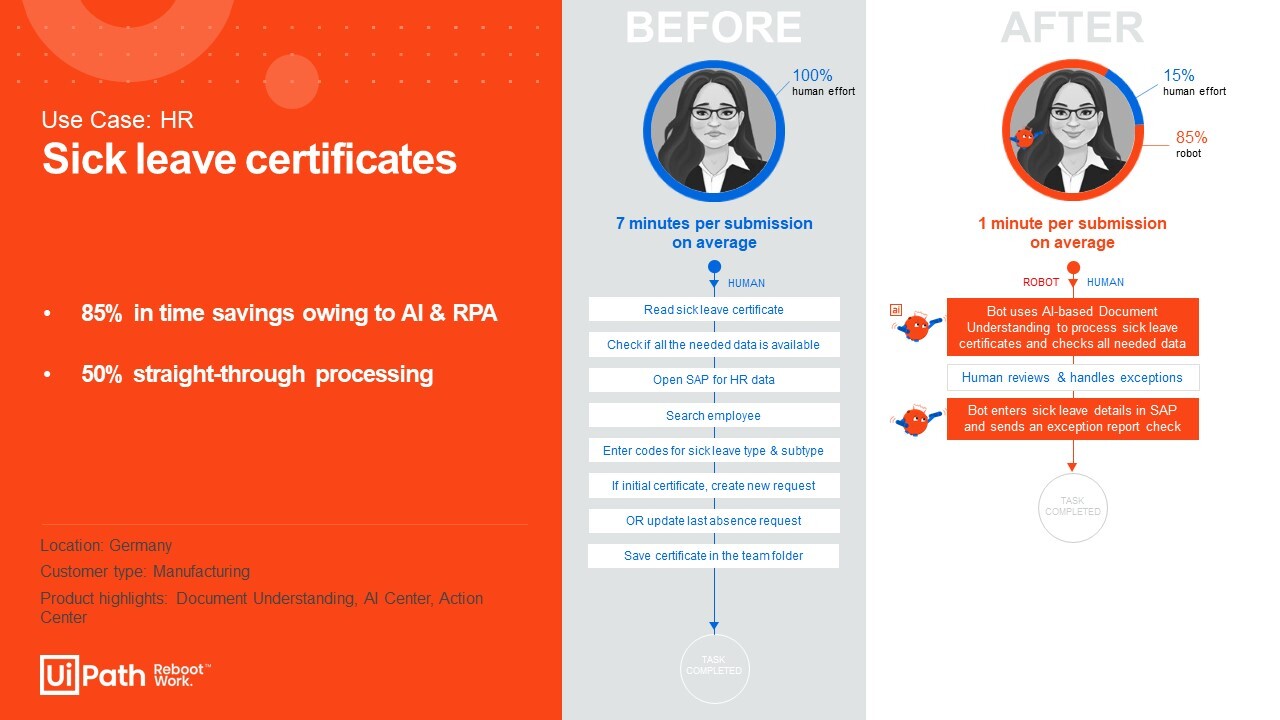
Client:Covestro
Industry:Manufacturing
Region:Europe
Covestro Leverages AI & RPA to Streamline Repetitive HR Processes

95%
accuracy
50%
straight-through processing
85%
reduction in time
500
documents per week
Client Overview
Covestro is a global premium polymers supplier headquartered in Germany with production sites, technical centers, and innovation hubs in Europe, Asia, and the United States.
A manufacturing company’s HR specialists save 85% of time previously spent on manual sick leave submissions – allowing them to focus on more valuable business tasks.
Covestro is one of the leading suppliers of premium polymers with headquarters in Germany and global representation across Europe, Asia, and the United States. The company's driving forces are ongoing innovation and sustainability.
Their dedication is evident in the continuous development of their products, processes, and facilities, which ensures an excellent customer experience as well as facilitates day-to-day workstreams.
Further advancing their internal work processes, Covestro was looking for a way to automate a common human resources (HR) process – sick leave certificates processing. According to Parimal Pashte, HR Digital Solution Analyst at Covestro, their HR team processes sick leave documents on a daily basis to comply with government regulations in Germany. Covestro, on average, deals with 500 PDFs and images per week, with the volume increasing to 600-650 documents during peak periods. And as the business grows, so will the number of employees, causing an increase in the volume of documents.
The main task is to read the employee sick leave certificates issued by a doctor and input the data into SAP for sick leave submission. Manually processing this task usually takes up to 7 minutes per one sick leave request.

Parimal Pashte • HR Digital Solution Analyst at Covestro
It was consuming a lot of time to go into the SAP system, find the right employee, input all the needed data into the system. The biggest challenge was to read these documents because the quality sometimes was really poor. And since this was a highly repetitive process that did not actually bring much business value, we decided to automate it to boost team’s performance.
Parimal Pashte • HR Digital Solution Analyst at Covestro
To automate this process, Covestro uses robotic process automation (RPA) complemented by artificial intelligence (AI) capabilities within the UiPath Automation Platform. As documents lay at the core of this process, the UiPath Document Understanding framework is used to digitize documents, classify them, and extract all needed data.
The documents are coming as scanned PDFs or pictures, so at first, OCR is used to make the text machine-readable.
The next step is classification, which helps determine the document type – whether a certain document is a sick leave certificate or not.
For data extraction, a machine learning (ML) model has been created in UiPath AI Center. It is trained to process sick leave certificates in German. More than 200 documents were used to train the model to understand such fields as person name, address, date of birth, illness start and end dates, recognize some checkmarks, and so on.
Whenever the extraction (or classification) confidence score is low, the output is sent for human validation via UiPath Action Center. The HR specialist can help confirm or correct the extracted data or send it for rejection in the case the document is not readable or includes a wrong file.
Once all the data is collected, the robot logins to SAP, finds the employee profile, and fills in all needed information to submit an absence form. Finally, the robot generates and sends an execution report.

This AI-enabled automation secures considerable time savings for our HR team. 50% of the documents are already going for straight-through processing with about 95% accuracy. So, our team only needs to review the robot’s output for half of the documents and spend as much as 1-2 minutes for their validation and exception handling.
Parimal Pashte • HR Digital Solution Analyst at Covestro
According to Parimal Pashte, the HR team finds it beneficial that they have more time to focus on crucial tasks that contribute to the overall increase in performance. “Now we have enough resources to work on bigger projects that we had on our to-do list for a while but had to deprioritize due to daily compliance processes.” Parimal Pashte adds that as soon as they saw the fast ROI from this implementation, the team started evaluating additional repetitive processes for automation.
Related case studies
Ready for your own case study?
Speak to our team of knowledgeable experts and learn how you can benefit from agentic automation.





